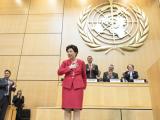May 10, 2010
Drills highlight gaps in H1N1 procedures
During the first weeks of the H1N1 pandemic last spring, drills to simulate resuscitation of pediatric patients showed that many healthcare workers failed to don proper protective equipment, according to Johns Hopkins research presented at the Pediatric Academic Societies annual meeting last week. Of 84 participants in simulations involving H1N1 and a cardiopulmonary event, only 51 used protective eyewear, 73 used gowns, and 68 used an N-95 or air-purifying respirator.
http://gazette.jhu.edu/2010/05/10/h1n1-drills-expose-gaps-in-hospital-infection-protection
May 10 JHU Gazette story
Ireland reports 1,600 vaccine reactions
More than 1,600 adverse reactions to the pandemic H1N1 vaccine were reported to the Irish Medicines Board, according to the Dublin-based Sunday Tribune. Two deaths were also reported, in people who had underlying conditions, but a link to the vaccine has not been proven. Fifteen people reported an "anaphylactic"-type reaction. Less serious reactions included injection-site problems, stomach upset, flu-like symptoms, dizziness, fainting, and limb weakness.
http://www.tribune.ie/news/home-news/article/2010/may/09/over-1600-suffered-ill-effects-from-swine-flu-jab
May 9 Sunday Tribune story
India region has almost 1% H1N1 case-fatality rate
A study of pandemic H1N1 flu lab investigations, hospital admissions, outpatient data, and mortality figures in the Pune metropolitan region of India showed a case-fatality rate (CFR) of almost 1%. The researchers found that confirmed H1N1 patients had a significantly higher risk of hospitalization than seasonal flu patients did. Of 93 flu deaths, 84 were from novel H1N1 and 9 from seasonal flu. Pandemic CFR was 0.86%, significantly higher than that of other countries.
http://www.plosone.org/article/info%3Adoi%2F10.1371%2Fjournal.pone.0010540
May 7 PLoS Med abstract
Flu still fairly quiet in Australia
Australia so far this year has confirmed 492 cases of influenza, of which 13% have been subtyped as pandemic H1N1; another 73% were influenza A but not subtyped. Less than 1% were A/H3N2, and 11% were type B, according to the country's Department of Health and Ageing (DHA). Two H1N1 patients were hospitalized. "Levels of influenza-like illness (ILI) in the community remain relatively low and reporting from laboratories indicates that little of this ILI is due to influenza," the DHA said.
http://www.healthemergency.gov.au/internet/healthemergency/publishing.nsf/Content/ozflucurrent.htm
May 10 DHA report


















